Classification of Ocimum basilicum Using a Convolutional Neural Network †
Abstract
1. Introduction
2. Methodology
2.1. Conceptual Framework
2.2. Prototype Block Diagram
2.3. System Flowchart
2.4. Dataset
2.5. System Hardware
3. Results and Discussion
4. Conclusions
Author Contributions
Funding
Institutional Review Board Statement
Informed Consent Statement
Data Availability Statement
Conflicts of Interest
References
- Chávez-González, M.L.; Rodríguez-Herrera, R.; Aguilar, C.N. Essential Oils: A Natural Alternative to Combat Antibiotics Resistance. A Natural Alternative to Combat Antibiotics Resistance. In Antibiotic Resistance: Mechanisms and New Antimicrobial Approaches; Elsevier Inc.: Amsterdam, The Netherlands, 2016; pp. 227–237. [Google Scholar] [CrossRef]
- Vijayashree, T.; Gopal, A. Comparison procedure for the authentication of Basil (Ocimum tenuiflorum) leaf using image processing technique. In Proceedings of the 2015 International Conference on Communication and Signal Processing, ICCSP 2015, Melmaruvathur, India, 2–4 April 2015. [Google Scholar] [CrossRef]
- Ramos, R.A.; Villaverde, J.F. Dried Water Lily Stem Validation for Weaving Fiber Production using K-Nearest Neighbors (K-NN) Classification Algorithm. In Proceedings of the 2024 7th International Conference on Information and Computer Technologies (ICICT), Honolulu, HI, USA, 15–17 March 2024; pp. 211–215. [Google Scholar] [CrossRef]
- Priya, G.L.; Baskar, C.; Deshmane, S.S.; Adithya, C.; Das, S. Revolutionizing Holy-Basil Cultivation with AI-Enabled Hydroponics System. IEEE Access 2023, 11, 82624–82639. [Google Scholar] [CrossRef]
- Cohen, M.M. Tulsi-Ocimum sanctum: A herb for all reasons. J. Ayurveda Integr. Med. 2014, 5, 251. [Google Scholar] [CrossRef] [PubMed]
- Mettripun, N. Thai Herb Leaves Classification Based on Properties of Image Regions. In Proceedings of the 2020 59th Annual Conference of the Society of Instrument and Control Engineers of Japan, SICE 2020, Chiang Mai, Thailand, 23–26 September 2020. [Google Scholar] [CrossRef]
- Buonopane, G.J.; Antonacci, C.; Lopez, J.L. Effect Of Cold Plasma Processing On Sweet Basil And The Biochemistry of Its Essential Oils. In Proceedings of the 2017 IEEE International Conference on Plasma Science (ICOPS), Atlantic City, NJ, USA, 21–25 May 2017. [Google Scholar] [CrossRef]
- Hortinela, C.C.; Balbin, J.R.; Fausto, J.C.; Divina, P.D.C.; Felices, J.P.T. Identification of Abnormal Red Blood Cells and Diagnosing Specific Types of Anemia Using Image Processing and Support Vector Machine. In Proceedings of the 2019 IEEE 11th International Conference on Humanoid, Nanotechnology, Information Technology, Communication and Control, Environment, and Management (HNICEM), Laoag, Philippines, 29 November–1 December 2019; pp. 1–6. [Google Scholar] [CrossRef]
- Abalos, M.R.; Villaverde, J.F. Fresh Fish Classification Using HOG Feature Extraction and SVM. In Proceedings of the 2022 IEEE 14th International Conference on Humanoid, Nanotechnology, Information Technology, Communication and Control, Environment, and Management (HNICEM), Boracay Island, Philippines, 1–4 December 2022; pp. 1–5. [Google Scholar] [CrossRef]
- Villaverde, J.F.; Ferrer, M.D.; Macabeo, J.A.T.; Manuel, J.T.M. Classification of Cotton Fabric, Pineapple Fabric and Cotton Pineapple Blend Fabric with VGG16 using Keras. In Proceedings of the 2023 IEEE 15th International Conference on Humanoid, Nanotechnology, Information Technology, Communication and Control, Environment, and Management (HNICEM), Coron, Palawan, Philippines, 19–23 November 2023; pp. 1–6. [Google Scholar] [CrossRef]
- Cadorna, J.F.G.; Cervantes, J.P.M.; IV, C.C.H.; Fausto, J.C. Identification of Salt Applying Image Processing and Machine Learning Techniques. In Proceedings of the 2023 IEEE 15th International Conference on Humanoid, Nanotechnology, Information Technology, Communication and Control, Environment, and Management (HNICEM), Coron, Palawan, Philippines, 19–23 November 2023; pp. 1–6. [Google Scholar] [CrossRef]
- Kavitha, R.; Kavitha, M.; Srinivasan, R.; Rajalakshmi, N.R.; Dhayanidhi, R. Basil Leaf Diseases Detection using Deep Learning architectures. In Proceedings of the INDICON 2022—2022 IEEE 19th India Council International Conference (INDICON), Kochi, India, 24–26 November 2022. [Google Scholar] [CrossRef]
- Muhali, A.; Linsangan, N. A Comparison of Keras Application Models with Pre-Trained Weights in Predicting the Disease of Lanzones Leaf. In Proceedings of the 2022 IEEE 14th International Conference on Humanoid, Nanotechnology, Information Technology, Communication and Control, Environment, and Management (HNICEM), Boracay Island, Philippines, 1–4 December 2022; pp. 1–6. [Google Scholar] [CrossRef]
- Manlises, C.O.; Santos, J.B.; Adviento, P.A.; Padilla, D.A. Expiry Date Character Recognition on Canned Goods Using Convolutional Neural Network VGG16 Architecture. In Proceedings of the 2023 15th International Conference on Computer and Automation Engineering (ICCAE), Sydney, Australia, 3–5 March 2023; pp. 394–399. [Google Scholar] [CrossRef]
- Malek, M.A.; Basak, S.; Reya, S.S. An Approach to Identify Diseases in Betel Leaf Using Deep Learning Techniques. In Proceedings of the 2022 4th International Conference on Sustainable Technologies for Industry 4.0, STI 2022, Dhaka, Bangladesh, 17–18 December 2022. [Google Scholar] [CrossRef]
- Desiderio, A.J.M.H.; Tenorio, A.J.F.; Manlises, C.O. Health Classification System of Romaine Lettuce Plants in Hydroponic Setup Using Convolutional Neural Networks (CNN). In Proceedings of the 2022 IEEE International Conference on Artificial Intelligence in Engineering and Technology (IICAIET), Kota Kinabalu, Malaysia, 13–15 September 2022; pp. 1–6. [Google Scholar] [CrossRef]
- Antolin, A.M.N.; Padilla, D.A.; Reyes, J.M.D. Tooth Condition Classification for Dental Charting Using Convolutional Neural Network and Image Processing. In Proceedings of the 2021 6th International Conference on Image, Vision and Computing (ICIVC), Qingdao, China, 23–25 July 2021; pp. 174–180. [Google Scholar] [CrossRef]
- Mhaski, R.R.; Chopade, P.B.; Dale, M.P. Determination of ripeness and grading of tomato using image analysis on Raspberry Pi. In Proceedings of the International Conference Communication, Control and Intelligent Systems, CCIS 2015, Mathura, India, 7–8 November 2015. [Google Scholar] [CrossRef]
- Yadav, H.; Bansal, P.; Kumarsunkaria, R. Color dependent K-means clustering for color image segmentation of colored medical images. In Proceedings of the 2015 1st International Conference on Next Generation Computing Technologies, NGCT 2015, Dehradun, India, 4–5 September 2015. [Google Scholar] [CrossRef]
- Dumaliang, D.M.; Rigor, J.M.Q.; Garcia, R.G.; Villaverde, J.F.; Cuñado, J.R. Coin Identification and Conversion System using Image Processing. In Proceedings of the 2021 IEEE 13th International Conference on Humanoid, Nanotechnology, Information Technology, Communication and Control, Environment, and Management (HNICEM), Manila, Philippines, 28–30 November 2021; pp. 1–6. [Google Scholar] [CrossRef]
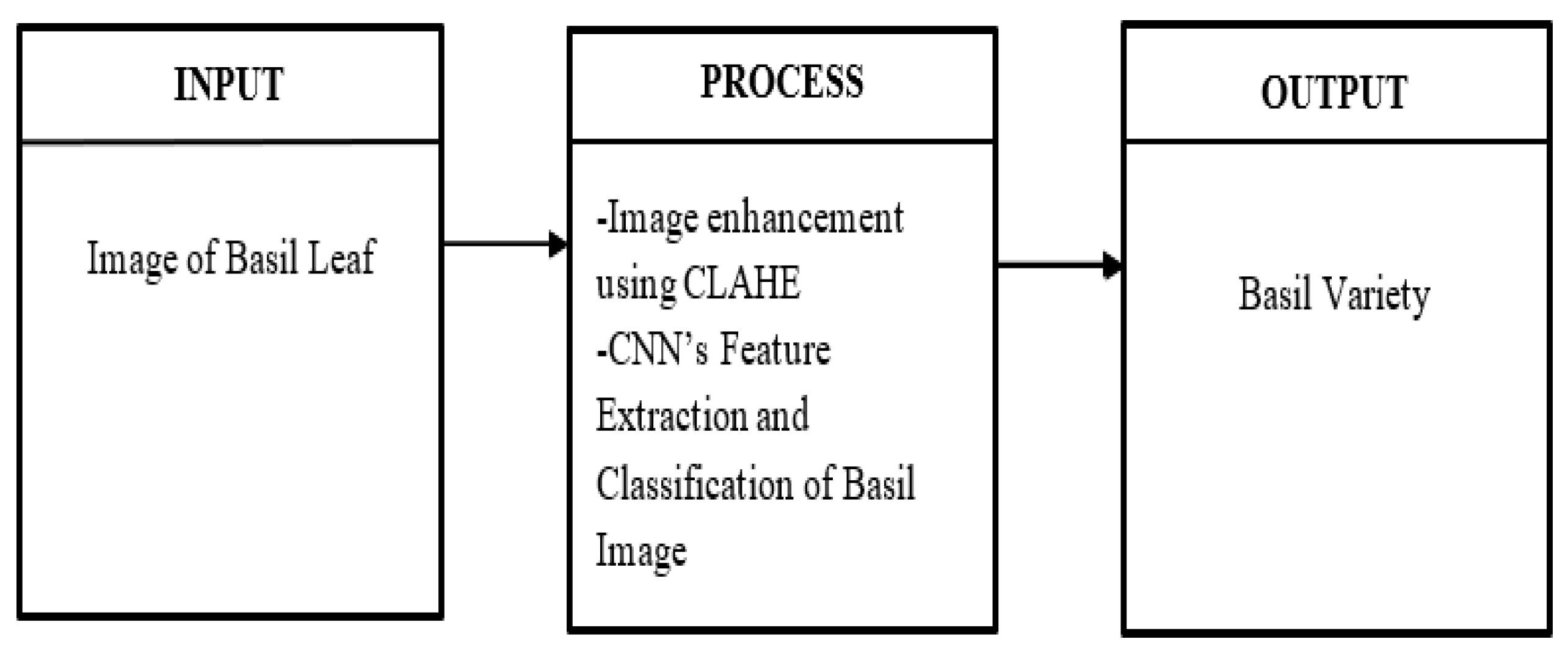
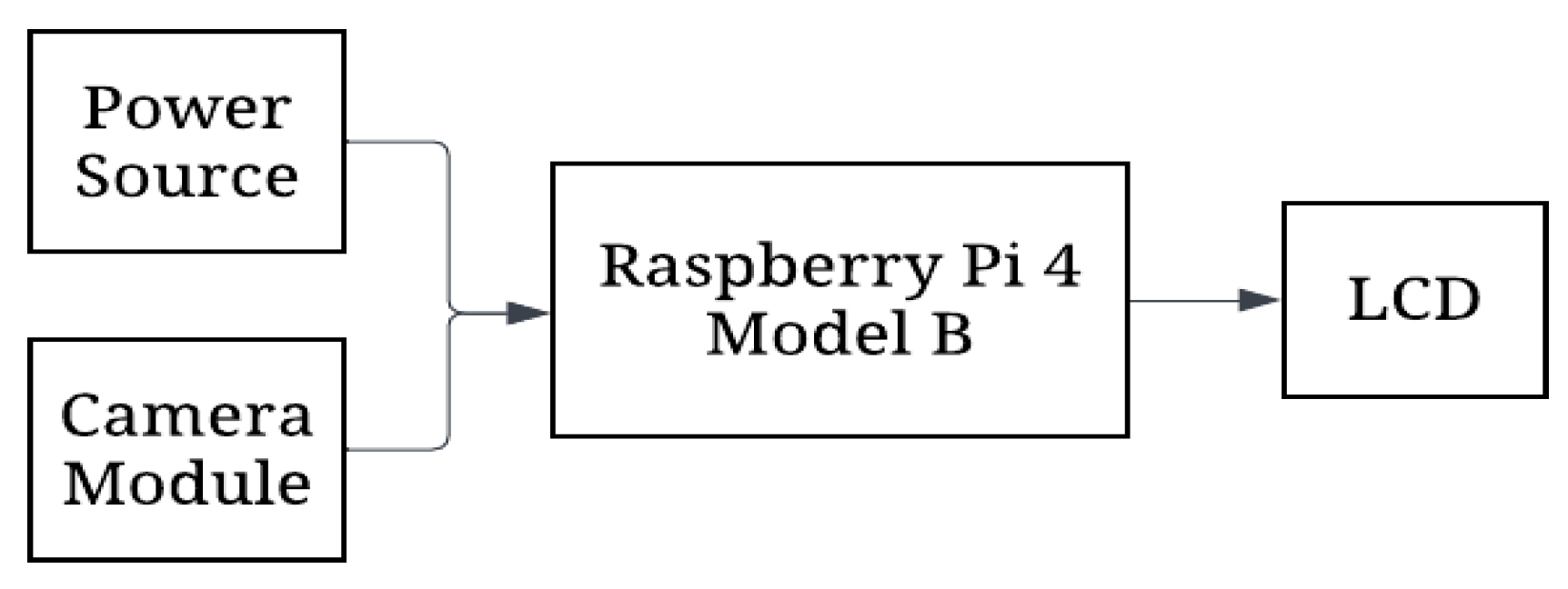

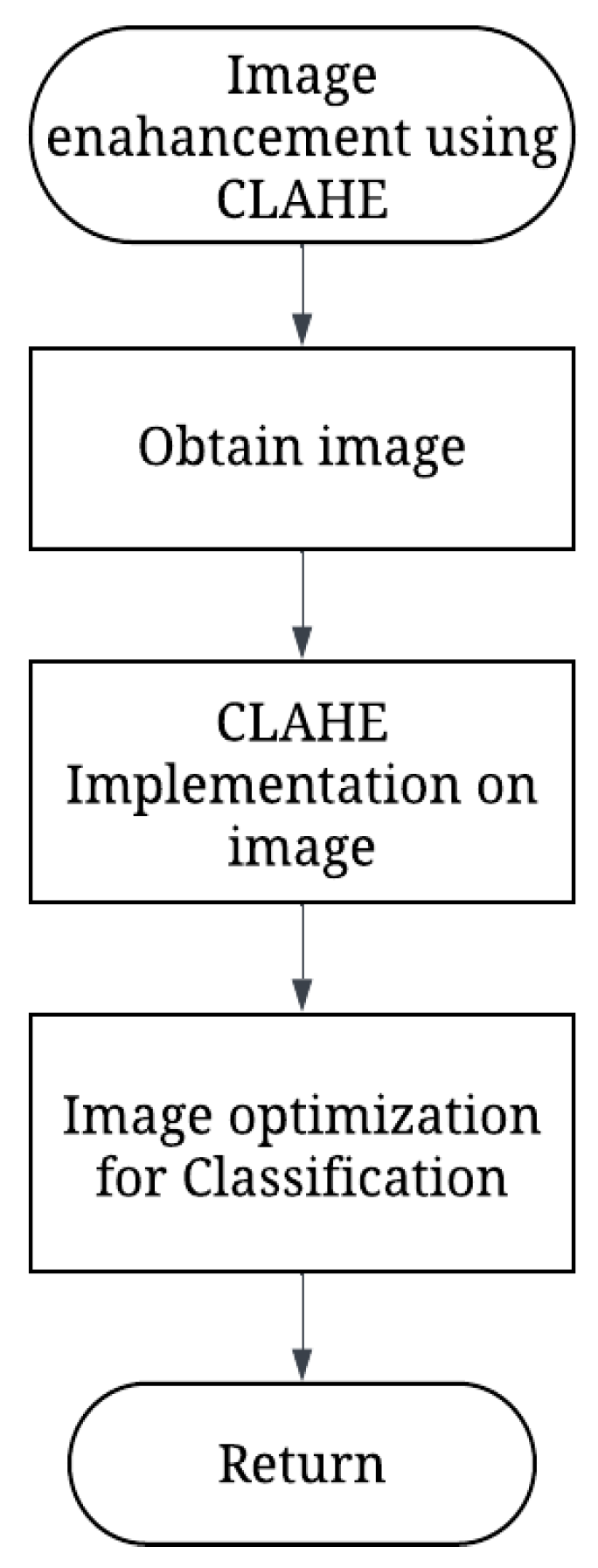
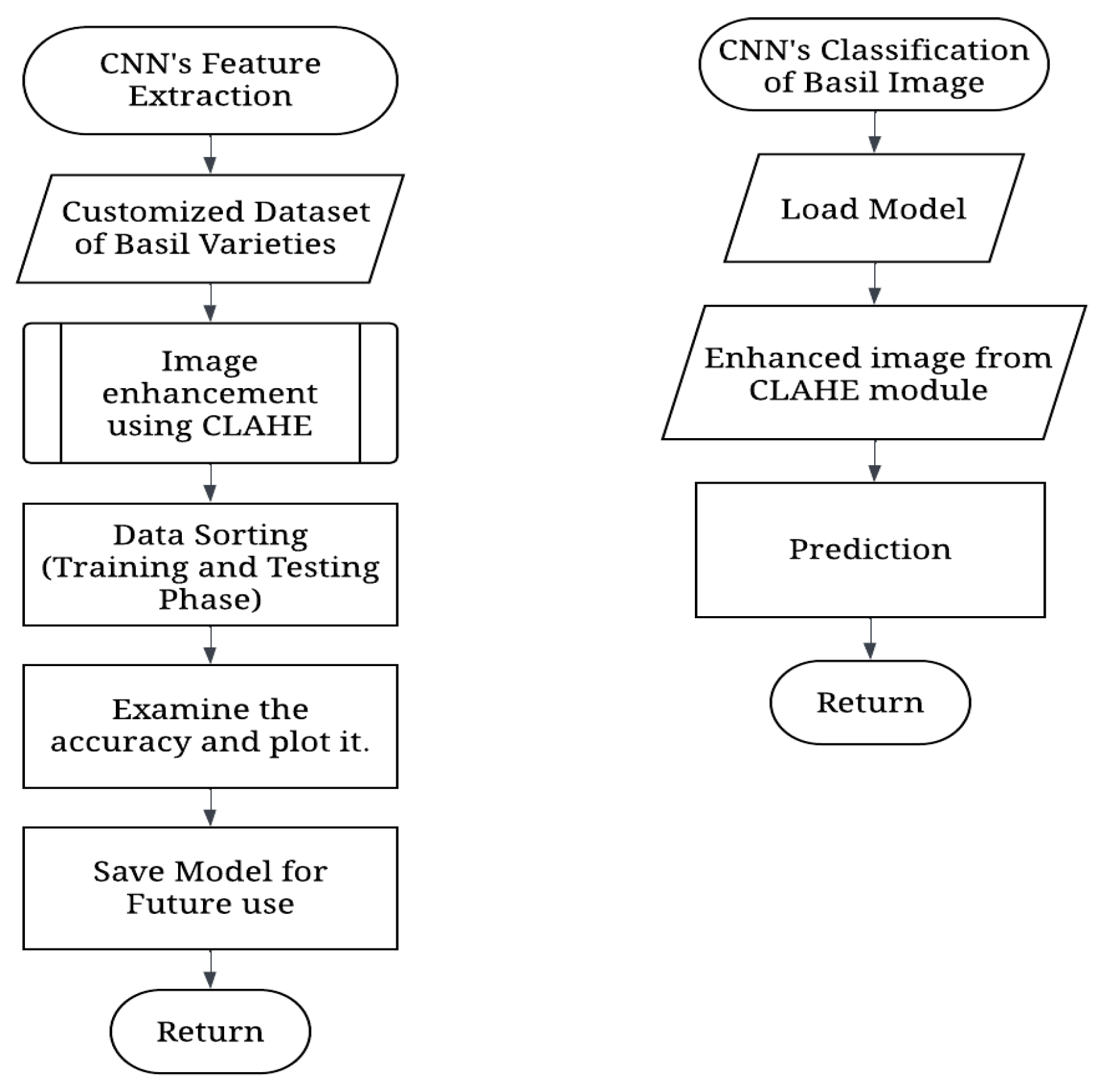


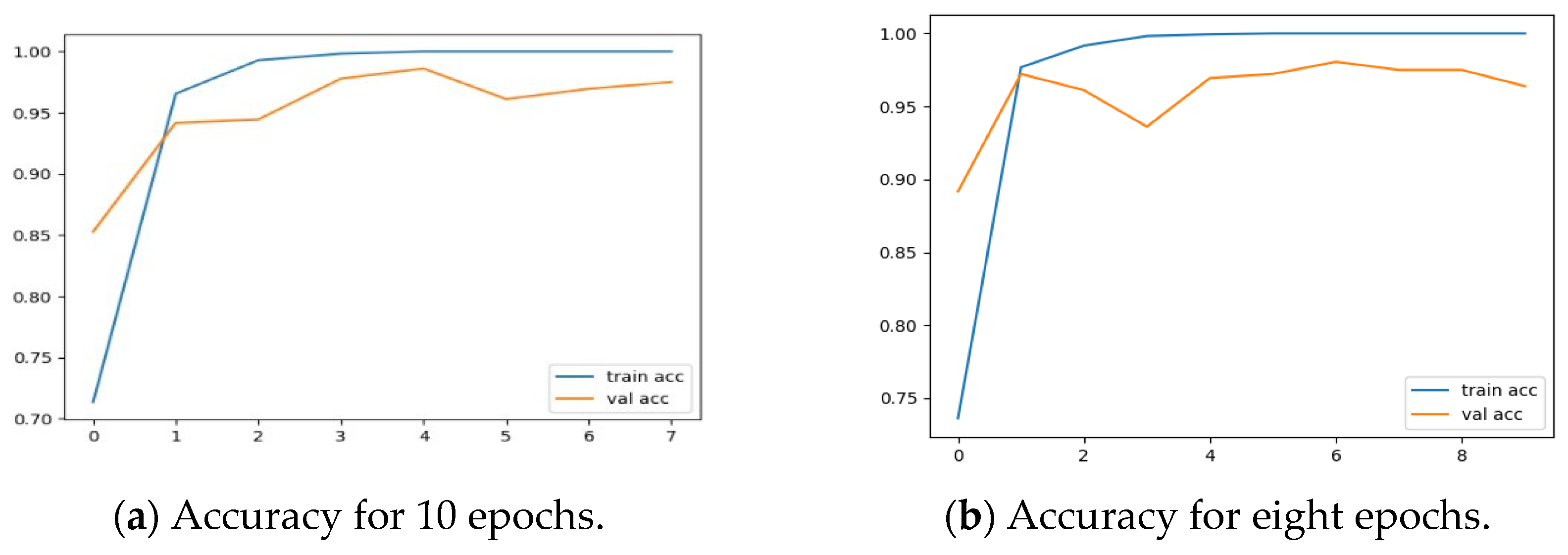
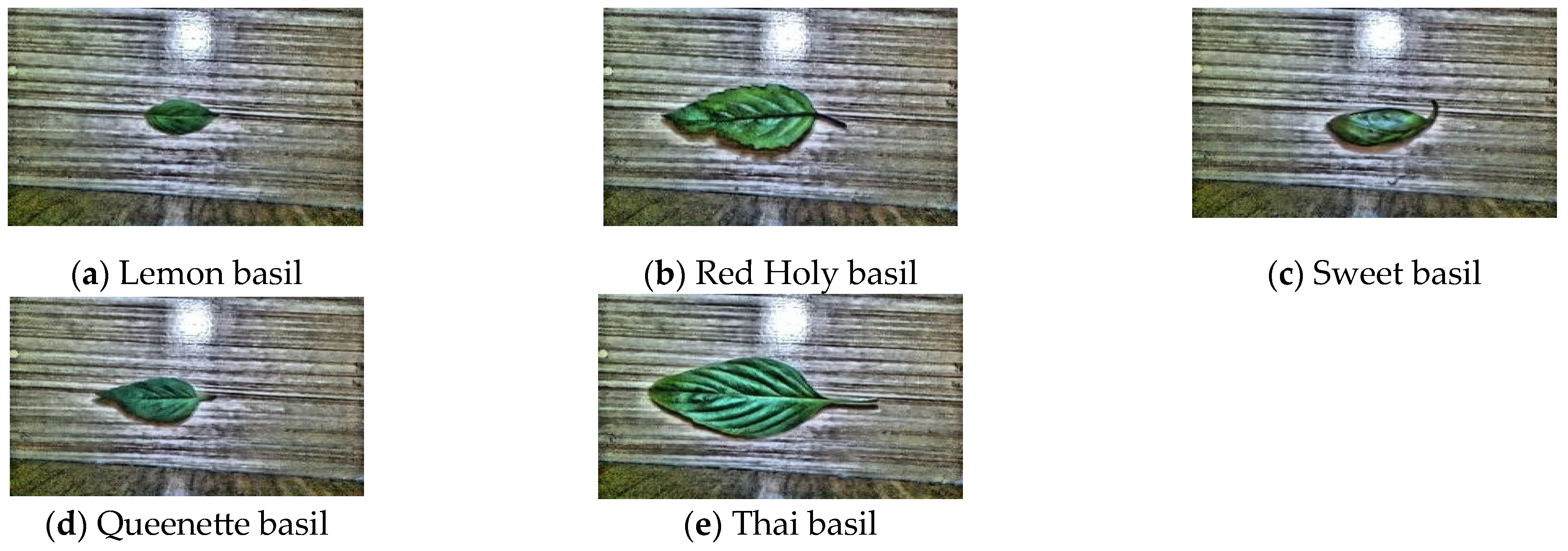
| Samples | Actual Species | Predicted Species |
|---|---|---|
| 1 | Sweet basil | Sweet basil |
| 2 | Thai basil | Thai basil |
| 3 | Holy basil | Holy basil |
| 4 | Lemon basil | Lemon basil |
| 5 | Queenette | Queenette |
| 6 | Red Holy basil | Red Holy basil |
| 7 | Sweet basil | Sweet basil |
| 8 | Thai basil | Thai basil |
| 9 | Holy basil | Red Holy basil |
| 10 | Lemon basil | Lemon basil |
| 11 | Queenette | Thai basil |
| 12 | Red Holy basil | Red Holy basil |
| 13 | Sweet basil | Red Holy basil |
| 14 | Thai basil | Thai basil |
| 15 | Holy basil | Holy basil |
| 16 | Lemon basil | Lemon basil |
| 17 | Queenette | Queenette |
| 18 | Red Holy basil | Sweet basil |
| 19 | Sweet basil | Sweet basil |
| 20 | Thai basil | Thai basil |
| 21 | Holy basil | Holy basil |
| 22 | Lemon basil | Sweet basil |
| 23 | Queenette | Queenette |
| 24 | Red Holy basil | Sweet basil |
| 25 | Sweet basil | Sweet basil |
| 26 | Thai basil | Queenette |
| 27 | Holy basil | Holy basil |
| 28 | Lemon basil | Lemon basil |
| 29 | Queenette | Queenette |
| 30 | Red Holy basil | Red Holy basil |
| 31 | Sweet basil | Sweet basil |
| 32 | Thai basil | Thai basil |
| 33 | Holy basil | Holy basil |
| 34 | Lemon basil | Queenette |
| 35 | Queenette | Queenette |
| 36 | Red Holy basil | Red Holy basil |
| 37 | Sweet basil | Sweet basil |
| 38 | Thai basil | Thai basil |
| 39 | Holy basil | Holy basil |
| 40 | Lemon basil | Lemon basil |
| 41 | Queenette | Queenette |
| 42 | Red Holy basil | Red Holy basil |
| 43 | Sweet basil | Lemon basil |
| 44 | Thai basil | Thai basil |
| 45 | Holy basil | Holy basil |
| 46 | Lemon basil | Lemon basil |
| 47 | Queenette | Queenette |
| 48 | Red Holy basil | Red Holy basil |
| 49 | Sweet basil | Sweet basil |
| 50 | Thai basil | Thai basil |
| Predicted | |||||||
|---|---|---|---|---|---|---|---|
| ACTUAL | Sweet Basil | Thai Basil | Holy Basil | Lemon Basil | Queenette | Red Holy Basil | |
| Sweet Basil | 7 | 0 | 0 | 2 | 0 | 2 | |
| Thai Basil | 0 | 8 | 0 | 0 | 1 | 0 | |
| Holy Basil | 0 | 0 | 7 | 0 | 0 | 0 | |
| Lemon Basil | 0 | 0 | 0 | 6 | 1 | 0 | |
Disclaimer/Publisher’s Note: The statements, opinions and data contained in all publications are solely those of the individual author(s) and contributor(s) and not of MDPI and/or the editor(s). MDPI and/or the editor(s) disclaim responsibility for any injury to people or property resulting from any ideas, methods, instructions or products referred to in the content. |
© 2025 by the authors. Licensee MDPI, Basel, Switzerland. This article is an open access article distributed under the terms and conditions of the Creative Commons Attribution (CC BY) license (https://creativecommons.org/licenses/by/4.0/).
Share and Cite
Perlas, M.A.N.; Santosildes, J.I.B.; Villaverde, J.F. Classification of Ocimum basilicum Using a Convolutional Neural Network. Eng. Proc. 2025, 92, 54. https://doi.org/10.3390/engproc2025092054
Perlas MAN, Santosildes JIB, Villaverde JF. Classification of Ocimum basilicum Using a Convolutional Neural Network. Engineering Proceedings. 2025; 92(1):54. https://doi.org/10.3390/engproc2025092054
Chicago/Turabian StylePerlas, Mary Angel N., John Isaac B. Santosildes, and Jocelyn F. Villaverde. 2025. "Classification of Ocimum basilicum Using a Convolutional Neural Network" Engineering Proceedings 92, no. 1: 54. https://doi.org/10.3390/engproc2025092054
APA StylePerlas, M. A. N., Santosildes, J. I. B., & Villaverde, J. F. (2025). Classification of Ocimum basilicum Using a Convolutional Neural Network. Engineering Proceedings, 92(1), 54. https://doi.org/10.3390/engproc2025092054






